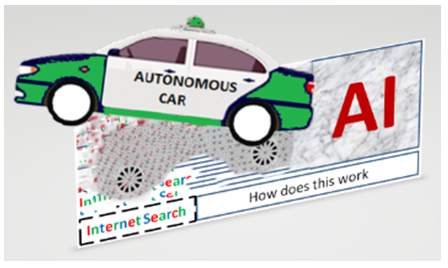 In exciting news this week Waymo™ the driverless car arm of Alphabet™ (the parent company of Google) launched its fully self-driving taxi service ‘Waymo One’ in Phoenix, Arizona. There is one catch though; the self-driving taxis each have a driver in them. What can we infer from this artificial intelligence (AI) enabled initiative and other offerings from the Alphabet conglomerate?
In exciting news this week Waymo™ the driverless car arm of Alphabet™ (the parent company of Google) launched its fully self-driving taxi service ‘Waymo One’ in Phoenix, Arizona. There is one catch though; the self-driving taxis each have a driver in them. What can we infer from this artificial intelligence (AI) enabled initiative and other offerings from the Alphabet conglomerate?
The technology challenges and the disappointing aspects are covered in news articles^. One might speculate many business reasons prompted the release of the driverless taxi service, as commonly perceived, ‘even though there is a designated driver in each vehicle’.
Let us hold on to above information that could prove to be one of the most impactful actions to our societal evolution and delve into another arm of Alphabet, Google. Google™ has become a practice-driven verb for internet search (sorry Bing, not comparable yet). Indeed, most in the world know the whole Alphabet conglomerate by the name Google – undoubtedly one of the most successful tech businesses of modern times. The search engine, and numerous free tools offered by Google that most of us devour, serve their quest to collect information and advance the technologies used in data collection and search process while fueling their most lucrative business arm: advertising.
Naturally, such extensive collection of information and algorithms used in their search engine are key to great social application of artificial intelligence (AI). Maybe it impacts all companies of the Alphabet conglomerate. Well, on closer introspection it turns out it is not so ‘naturally’ as I phrased in the beginning of this paragraph.
Why?
- It is now well known in educated community that with that form of data collection and the existing algorithms, we often end up with AI based insights reflecting the biases in the society that is embedded in the data.
- The search and inference algorithms, though one of the most singular tech stack with so much monetary impact for them, turns out to be not that great.
The first of the two points above is intuitive and evident for those who think and observe hard enough.
The second one, algorithms mining all that data, enables the search engine, lets them win AlphaGo against humans and launch Waymo One. One of the reasons that forces the launch of Waymo ‘autonomous taxi service’ to have a dedicated driver per vehicle is that the ability to model human behavior on the streets cannot be well predicted. Mind you, I am as amazed and excited as many about the impact this launch could have on our society and the societal advancements and tech distribution that the free Google products have brought about.
If we look deeper, the complex tasks as predicting ‘edge case’ human behavior on the street (that would be far less in volume than common behavior) will be key for Waymo services to be REALLY DRIVERLESS. Currently sparse but useful signals cannot be detected well by their algorithms and can easily be suppressed by dominant information. I highlight this with easy to relate and simpler use cases in the examples below.
Use case 1:
There is a decision analytics business ReSurfX™* with over a dozen issued patents, with use of the word ReSurfX in public domain from 2005, owning a web domain in that name since 2009 and has been recognized with many accolades. From late 2014 a company Lumenis Inc** started to use that rare name resurfx with three different upper case letters for a single module in their aesthetic laser product. As devious at it sounds, a ‘Google search’ for ‘resurfx’ will not find the former business in several initial pages of search results***. The point highlighted from this example is, when people use Google search the most useful results will (i) get variety of relevant information not just ones with high signals, and (ii) be bias reduced – (i.e., algorithms correcting for bias even if the data inherently has them).
Use case 2:
As people go in to search about their health etc. someone like the company selling aesthetic solution in the previous example can currently impact the search algorithms and deliver misguiding dominant information to the search user. This obvious shortcoming diminishes the power of AI and effective knowledge extraction. Maybe this is a reason for previous forays of Google in healthcare space, like the ‘Google Health‘ for being unsuccessful .
Indeed for applications as ‘driverless cars’ and ‘healthcare treatment’ such non-obvious and ‘not so strong’ signals might prove to be the key to success.
In conclusion, to be successful in broader initiatives that rely on artificial intelligence (AI) and breadth of data, there currently is a strong need and room for a new search and inference engine besides Google.
Share what you think using the comment option.
^ Couple of news articles on Waymo launch covering this aspect. https://www.wired.com/story/waymo-self-driving-taxi-service-launch-chandler-arizona https://arstechnica.com/cars/2018/12/waymos-lame-public-driverless-launch-not-driverless-and-barely-public/ * https://resurfx.com ** https://lumenis.com *** https://resurfx.com/resurfx-what-is-in-a-name/

Hmm, very insightful. AI, Data Mining, Big Data Analysis, IoT etc the buzzwords now. Good to see you Suresh involved in the latest trends and being successful. Way to go…
Thanks Syam. If you perceive buzzwords – the blog site is centered on ‘impact of emerging themes in technology and policy on society,….’